
3-5 Workdays Article No. 2745
Article No. 2745

3-5 Workdays Article No. 2746
Article No. 2746
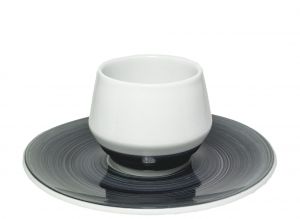
3-5 Workdays Article No. 2749
Article No. 2749
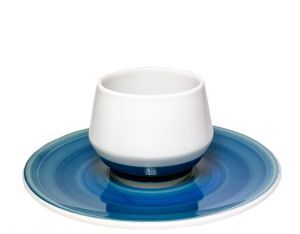
3-5 Workdays Article No. 2747
Article No. 2747
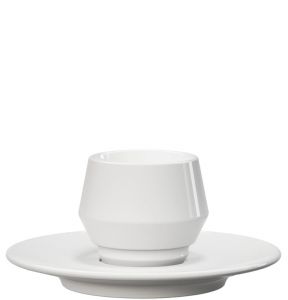
3-5 Workdays Article No. 2748
Article No. 2748
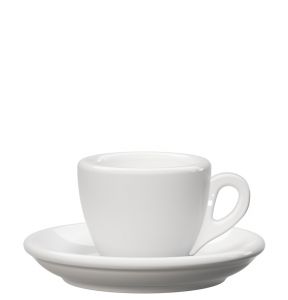
3-5 Workdays Article No. 2593
Article No. 2593
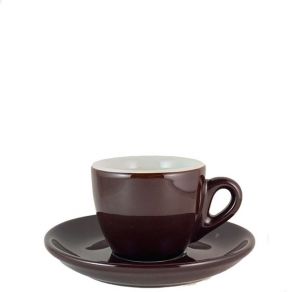
3-5 Workdays Article No. 2594
Article No. 2594
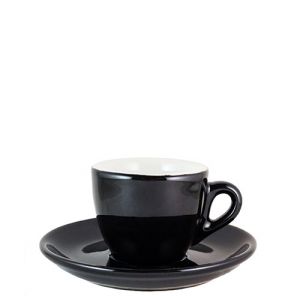
3-5 Workdays Article No. 2595
Article No. 2595

3-5 Workdays Article No. 2786
Article No. 2786

3-5 Workdays Article No. 2785
Article No. 2785

3-5 Workdays Article No. 2789
Article No. 2789

3-5 Workdays Article No. 2782
Article No. 2782

3-5 Workdays Article No. 20010
Article No. 20010

3-5 Workdays Article No. 20009
Article No. 20009
Coffee cups
“Ma cu sti mode, oje Bríggeta/ Tazza 'e café parite/ Sotto tenite 'o zzuccaro,/ E 'ncoppa, amara site...”
(But with these manners, oh Bridget, you look like a cup of coffee. Underneath you hide the sugar and on top, instead, you are bitter, Roberto Murolo, A Tazza 'E Café).

These are the words of one of the great composers of Neapolitan music, one of the most distinctive and ancient sounds of the entire Italian panorama, whose main exponents include celebrities such as the late Roberto Murolo and Pino Daniele, as well as present-day stars such as Nino D'Angelo and Gigi D'Alessio.
In these short verses, now engraved in the singing history of the Belpaese, the beauty and uniqueness of a woman are told through a metaphor with an intense and decisive flavour: a cup of coffee. Two of the most pregnant sides of Naples, poetry, and coffee, find the perfect amalgam to support another character that has enduringly belonged to the people of Campania: charm and the ability to exalt beauty in all its forms.
At the centre of the notes, amidst deep voices and vibrating strings, always her, the dish and drink that resides in the hearts of enthusiasts and simple consumers around the world, but above all on the Italian peninsula: coffee.
Here we will deal with the instrument, the vector, through which this "black ambrosia" touches the lips and tickles the palate of everyone every morning, every evening and (why not) for some even every night.
The history of coffee cups
 For centuries, the cup has been the perfect container for coffee, far more suitable than a simple table glass, a delicate goblet or a small glass inlaid with the most varied motifs. Although coffee can also be served in a glass, the porcelain cup seems to be the ideal key to serving a drink to its full potential, as the intrinsic characteristics of the material allow it to retain heat for longer, thus helping to enhance the taste of the coffee itself as fully as possible.
For centuries, the cup has been the perfect container for coffee, far more suitable than a simple table glass, a delicate goblet or a small glass inlaid with the most varied motifs. Although coffee can also be served in a glass, the porcelain cup seems to be the ideal key to serving a drink to its full potential, as the intrinsic characteristics of the material allow it to retain heat for longer, thus helping to enhance the taste of the coffee itself as fully as possible.
But where did the cup come from?
Who was its inventor and what etymology lies behind its name?
The Italian word for cup, ‘la tazza’, seems to have its origin in the Arabic 'tassah', an ancient traditional glass in the Middle Eastern world in which drinks were customarily served. Arabia, or in any case the world beyond the Mediterranean Sea and the natural borders of Turkey and the Caspian Sea, always comes up when talking about coffee.
The Arabica variety is one of the main components of the coffee we all enjoy on our tables today. The spread of the coffee cup in Europe seems to date back to the Middle Ages, more precisely to the time of the Crusades, when armies of subjects of the Pope and the Christian religion went to Islamic lands to fight against the 'infidels'.
According to the most attested historiographical sources, in fact, tableware services in majolica or porcelain already in the 15th and 16th centuries included the beloved coffee cups, with a narrower bottom than the upper part, with or without a lid, but all without a handle. Decorated in most cases with a variety of motifs, from geometric to floral and landscape, they were the ones who welcomed coffee to our tables when it arrived in Europe during the 17th century.
Coffee cups and the strange way to use them
Today we know coffee cups as an integral part of a set that also includes a metal or, for more frugal occasions, plastic spoon, and a saucer, almost always matching the cup in both color and material composition. However, this was not always the case. If coffee cups appeared in Europe during the 15th and 16th centuries, saucers arrived much later, only during the 18th century, and immediately took over, so much so that they became the protagonists of a custom that today, we would think we were dealing with a madman. In those days, the saucer was used to cool coffee. How? It was poured on it to be drunk from the saucer itself. It did not take long, however, for this custom to be considered inelegant, or even offensive, and it soon fell into disuse.
Professional cooks, however, still today use saucers to test for salt for example in hot soups, as this is a very effective and quick way to cool down hot liquids.
Up to this point in history, the term 'cup' has always been used to refer to the coffee container. Why? The reason lies in the fact that the coffee cup as we know it today was only invented in the mid-eighteenth century in England by the Briton Josiah Wedgwood, who perfected the use of majolica. And the name tazzini? It is not a diminutive of ‘tazza’, as many might think at first glance, but owes its origin to an Italian, Luigi Tazzini, the true promoter of the modern form of coffee cups.
He designed several, each suited to a specific use: "el tazzinin" for drinking espresso coffee, "el tazzin" for wine and "la tazzinetta" for milk coffee. This led to a meticulous and precise production, made of special materials and techniques aimed at enhancing just one element: espresso coffee.
The Importance of the right espresso cups
 Espresso cups are the first thing a true Italian Espresso lover sees when he or she wakes up, and they are the perfect companions for every moment of break and relaxation, alone or in company, at work or in leisure time. From the inside, they release the taste and aromas of a boiling blend of exotic beans, ground and extracted at high temperature. The result of this harmony gives a tasty and elegant break, the right step to start the day with sprint. Be careful though, all this is only possible if you use the perfect espresso cup for your needs. Espressocups are not only used to hold the drink but also to enhance its taste, color, aroma and flavor. The right cup has a balance between design and practicality, which is why it is essential to use the perfect cup, to make the most of this heavenly moment.
Espresso cups are the first thing a true Italian Espresso lover sees when he or she wakes up, and they are the perfect companions for every moment of break and relaxation, alone or in company, at work or in leisure time. From the inside, they release the taste and aromas of a boiling blend of exotic beans, ground and extracted at high temperature. The result of this harmony gives a tasty and elegant break, the right step to start the day with sprint. Be careful though, all this is only possible if you use the perfect espresso cup for your needs. Espressocups are not only used to hold the drink but also to enhance its taste, color, aroma and flavor. The right cup has a balance between design and practicality, which is why it is essential to use the perfect cup, to make the most of this heavenly moment.
The perfect espresso cup
Like many other kitchen objects used all over the world, coffee cups are the fruit of Italian passion and ingenuity. They are simple only in appearance; in fact, their shape is carefully studied to enhance the drink they contain. Their ideal shape means they are narrower at the base, with a curved bottom to facilitate the raising of the creama, wider at the top to release and amplify the aromas and with a well-proportioned handle to facilitate a firm grip without any inconvenience. Each cup, of course, must be accompanied by the right saucer, which serves to collect any drops of coffee spilled and to support the spoon. The important thing is that each cup has the right properties.
The best espresso cups are those made of thick glazed ceramic, perfect because they do not alter the taste of the coffee and because they maintain the optimal temperature of the contained drink for as long as possible. Each coffee cup can contain from 40 to 50 ml of beverage: the ideal size if we keep in mind that the classic espresso is only 25 ml. The extra space serves to prevent the coffee from spilling out when the spoon is dipped or when a larger quantity of drink is poured, for example for a long coffee or a macchiato.
A new espresso cup set for a new experience
 There are several ways to drink coffee. There are those who prefer a small espresso, those who prefer to stretch it with a little milk or boiling water, those who enjoy it bitter and those who need sugar. Coffee is love, and we know that the heart is not in command, so everyone has the freedom to taste it as they wish. Coffee cups are also designed to meet different needs. They can be larger, smaller, colorful, white, decorated, round, or square. The important thing is that the character of each cup reflects the personality and character of the person who uses it. A set of new coffee cups is the ideal gift, for yourself or for friends and relatives who love coffee. We must not underestimate the value that a new service can bring to our tables.
There are several ways to drink coffee. There are those who prefer a small espresso, those who prefer to stretch it with a little milk or boiling water, those who enjoy it bitter and those who need sugar. Coffee is love, and we know that the heart is not in command, so everyone has the freedom to taste it as they wish. Coffee cups are also designed to meet different needs. They can be larger, smaller, colorful, white, decorated, round, or square. The important thing is that the character of each cup reflects the personality and character of the person who uses it. A set of new coffee cups is the ideal gift, for yourself or for friends and relatives who love coffee. We must not underestimate the value that a new service can bring to our tables.
From the beautiful, understated, soft, rounded lines of the classic cup to the more extravagant lines of modern cups, a new set can add that touch of originality, art and color that our kitchen needs. It can break the monotony and renew the coffee experience. It can finally replace the old set of which we do not even have all the pieces anymore. In conclusion, we can say that having the perfect cup brings advantages in many ways: it will make your coffee break more enjoyable, decorate and complete your kitchen and capture the attention of your guests.
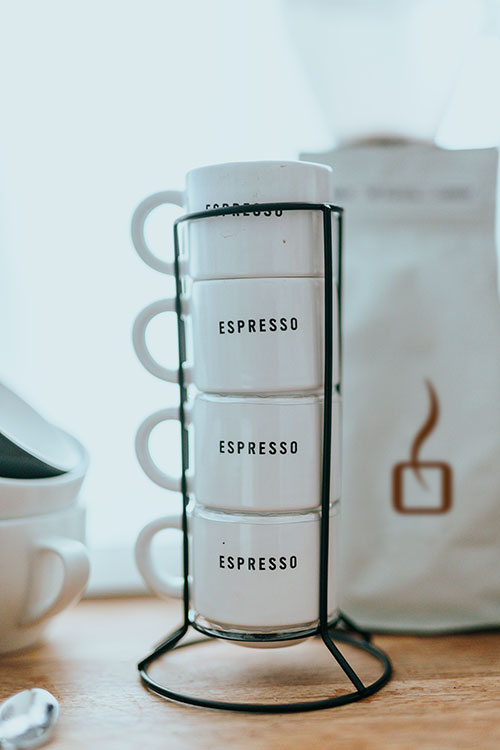 Espressocups & Espresso coffee cups
Espressocups & Espresso coffee cups
The espresso is a popular coffee drink worldwide, which is part of the daily life of millions of people. With espresso, hot water is pressed through the finely ground coffee powder at high pressure, resulting in an enjoyable coffee with a delicate golden-brown cap. Every good espresso comes with a suitable espresso cup.
In the following text we will go into all the important points you should know about an espresso cup.
Espresso cup - Is it important or not?
The taste of espresso, which has been characterising the coffee market for years, is also dependent on the right espresso cup. The right espresso cup of the mysterious espresso not only makes a visual impression, but it also plays an important role in the following enjoyment.
The preparation, as well as the shape of the cup, are essential for the taste of the espresso, which is also simply called "Caffe" in the country of origin, Italy. Since there are many cups to choose from, we have made available exclusively the highest quality espresso cups in our range.
Which cup should you choose? We have compiled some points for you.
Espressocups - All you need to know
Finding the right espresso cup is not always so easy due to the large amount of choice available. We have listed some criteria that can help you to choose the cup that best matches your needs.
- The shape of the espresso cup is important because of the " crema " (the golden-brown foam). The size of the diameter at the top of the cup should, as far as possible, be larger than the base of the cup. The explanation is very simple: the crema can expand better above the cup, and this creates the wafer-thin arc around the edge of the cup. Besides this fact, of course, your own taste also decides, so there are enough possibilities to choose from the shapes as well as different colors.
- Espresso cups should have a capacity of between 50ml and 90ml because 25-30ml of water is traditionally used to make espresso. This leaves enough space for the crema and if it is necessary, you can add some frothed milk to fill to the edge of the cup.
- The pleasant sensation as soon as the cup is in your hand is very important and therefore decides on comfort while drinking.
- The espressocups should usually have a "thick" wall that helps to prevent the preparations from cooling down too quickly so that you can still enjoy the drink hot. The brewing temperature we recommend is between 86-95°C, which varies depending on the roasting of the beans. You should always warm up the espresso cup in advance. This can be done with boiled water, which can remain in the cup for just under a minute before you pour it out for the actual drink.
- Most espresso cups are either made of glass or porcelain. As already mentioned, a high quality determines the perfect success of the espresso, so it is well worth spending a few more Euros on it. The espresso cups can be used for years, so it can be seen as a one-time investment.
You are welcome to have a look at the espresso cups in our assortment, we are sure that there is something for your taste.
The production of porcelain espresso cups and saucer sets
Have you ever asked yourself how these porcelain cups are made? Why are they different from other cups? What raw materials are these cups made of?
We would like to answer these and other questions in the following text.
What do Espresso cups consist of?
The origin of porcelain production:  For the production of porcelain espresso or cappuccino cups, three main components are used: kaolin, quartz, and feldspar.
For the production of porcelain espresso or cappuccino cups, three main components are used: kaolin, quartz, and feldspar.
The kaolin constitutes 50% of the materials used for the cup and is also known as aluminum silicate, porcelain clay, or porcelain earth. It consists of silicon oxide, aluminum oxide, and also silica. Depending on the country of production and the cultivation area, different amounts of "impurities" are contained.
The proportion of quartz is about 25%. From a chemical point of view, quartz is silicon doxide. In rural areas, quartz is also known as quartz sand, which is used to produce porcelain and ceramics as well as for the cement and glass industry.
Feldspar also contributes its share of 25%. It is a silicate mineral, in which other elements such as aluminum, sodium, barium, calcium, and others can be found.
How are Espresso cups made?
Sometimes, the raw minerals must be purified to remove disturbing substances. Then they are pulverized and mixed in drum mills. Depending on the company, other substances such as casting materials are also added. These are an important factor during processing and for the later final product, in our case the espresso cups.
The saucers of the espresso cups
An automatic lathe is used for the saucers, while the casting process is used for the cups. This means that the liquid raw porcelain is filled into a negative imprint of the espressocups, which gives them their shape. After a sufficient rest period, the cups are removed from the printing process. Now only the handle is missing, which is also glued with a thick porcelain mass.
 The saucers can also be manufactured with the raw porcelain in a negative mould. After the finished saucer has rested enough, it is carefully removed from the mold. This requires a steady hand because the saucer can wobble if it fails.
The saucers can also be manufactured with the raw porcelain in a negative mould. After the finished saucer has rested enough, it is carefully removed from the mold. This requires a steady hand because the saucer can wobble if it fails.
The saucers that have their resting surface in the middle are easier to make than others that do not have their resting surface exactly in the middle.
The handle of the cup
The part where the most can go wrong and where most hands are needed is the handle of the cup. The procedure to ensure that the handles are straight and at the right position requires a lot of practice and concentration. Finally, the transition between the grip and the handle should be neat. If the handle is not applied firmly enough, gaps can appear which look unattractive and carry the risk that the handle may break off relatively early.
During the process, the inside of the handle is carefully checked and reworked.
The burning of the cups
After the cups have been taken out of their molds, the next step is the pottery kiln. The first firing is done with a temperature of almost 900-1000°C, which can last for 17-20 hours. After this process, the surface is still somewhat rough and fragile.
 The next step is the glaze firing. For this, enormous temperatures up to 1500°C are required. The cups are sometimes in the oven for up to 30 hours and the porcelain sinters, meaning that it is heated just below melting temperature, so the pores are reduced which also leads to contraction, but the shape remains stable. After the glaze firing, the cups have a much smaller volume.
The next step is the glaze firing. For this, enormous temperatures up to 1500°C are required. The cups are sometimes in the oven for up to 30 hours and the porcelain sinters, meaning that it is heated just below melting temperature, so the pores are reduced which also leads to contraction, but the shape remains stable. After the glaze firing, the cups have a much smaller volume.
Pictures, motifs and colors on the cups - espresso mugs
The cups that have pictures, patterns, or different colors are made using foils, or the cups are painted by hand. These cups must suffer another firing at a heat of up to 900° C. It is often noticed that the colors of the motifs often change during the firing. The final color can only be seen after the last firing. To be able to estimate the color changes, it requires a long time, much experience, and discipline.
What is the difference between espresso and mocha cups?
Mocha cups have a long tradition, and the preparation of mocha coffee is different from other coffee drinks. Especially in Turkey or Greece, this preparation is very popular. The mocha is brewed with special beans, which may have a chocolate note, boiled usually with quite a bit of sugar a couple of times in a special mocha pot. Because the coffee grounds stay in the pot during the boiling process and are transferred, cups with a narrow bottom should be chosen. This lets you only lean the cup slightly while drinking, allowing you to enjoy your drink without stirring up the coffee grounds.
Since the coffee grounds do not stay in the base of the classic espresso, you can also use cups with a slightly wider base.
Mocha cups from Turkey/Greece
 The Turkish mocha cups are usually very thick-walled, as the mocha is served very hot. In Turkey, the mocha has a high caffeine content of about 130mg. Most of the time, Turkish mocha cups have inscriptions with oriental designs. Porcelain cups can also be set in a cage made of zamac, an alloy of zinc and copper, or made only of this alloy. They can be served with a lid modeled after an oriental dome.
The Turkish mocha cups are usually very thick-walled, as the mocha is served very hot. In Turkey, the mocha has a high caffeine content of about 130mg. Most of the time, Turkish mocha cups have inscriptions with oriental designs. Porcelain cups can also be set in a cage made of zamac, an alloy of zinc and copper, or made only of this alloy. They can be served with a lid modeled after an oriental dome.
 The traditional Greek mocha cup is typically white and has no hole in the handle. It has a matching saucer and a small spoon. Of course, there are also models with motifs and writing on the Greek mugs, in which the plain white corresponds to the Greek standard.
The traditional Greek mocha cup is typically white and has no hole in the handle. It has a matching saucer and a small spoon. Of course, there are also models with motifs and writing on the Greek mugs, in which the plain white corresponds to the Greek standard.
Espresso cups sets for what occasion? Your call …
To enjoy the perfect coffee, we have a variety of cups in different shapes and with different motifs. There are typical porcelain cups with round or square handles, but also glass espresso cups, which give us an optimal view on the content of the coffee. Many companies that used to only sell coffee have also entered the production of coffee cups.
 So it is possible to buy single cups and saucers or even complete sets from the most exclusive brands such as Lucaffè, Essse Masini, La Tazza d'oro, Lavazza and many more.
So it is possible to buy single cups and saucers or even complete sets from the most exclusive brands such as Lucaffè, Essse Masini, La Tazza d'oro, Lavazza and many more.
If you are looking for a set with a retro look, the Vintage cup set from Caffè Mauro is a perfect choice.
Espresso cups set as a gift
In the picture you see the Mauro set. A great gift for any coffee break, whether at home or in the office.
There is a wide selection of white espresso cups, brown espresso cups, and designer espresso cups.
If you do not care too much about the "thickness" of the cups, you can choose from those with a more exclusive design. If you prefer colorful motifs, you should take a look at the high-quality cups from Lucaffè. The most important factor is that the top has more surface area than the bottom so that the golden-brown crema can develop. We recommend ordering the cup and the saucer from the same manufacturer they fit and do not wobble.
From the beautiful, understated soft, rounded lines of the classic mug to the more whimsical lines of modern cups, a new set can add that touch of originality, artistry and color that a kitchen needs. It can break the monotony and renew the coffee experience. It can finally replace the old set that we do not even have all the pieces of anymore.
The cup should please you personally and therefore we hope that we could help you with these numerous information and tips.
Different types of coffee cups
In addition to their own coffee blends in all specialities, each brand also produces its own assortment of coffee cups, accompanied by saucers and spoons, some of which are truly unique. Simple, monochrome, or even achromatic, showing the natural appearance of porcelain. Or painted and enriched with special decorations, dedicated to a particular historical period, a time of year or inspired by vegetation, geometric patterns, and fantasy shapes. The coffee cups available on the market can really satisfy all tastes, even the most demanding.
 One of the most characteristic products is certainly the ceramic coffee cup made and offered by Sant'Eustachio. With its characteristic bright yellow color, it has ribs on the outside that vaguely resemble the plastic containers of vending machines, thus combining practicality with aesthetic taste. A company-designed spoon is also available, with a unique curved shape that allows it to perch on the rim of the cup-like an owl waiting to find its prey.
One of the most characteristic products is certainly the ceramic coffee cup made and offered by Sant'Eustachio. With its characteristic bright yellow color, it has ribs on the outside that vaguely resemble the plastic containers of vending machines, thus combining practicality with aesthetic taste. A company-designed spoon is also available, with a unique curved shape that allows it to perch on the rim of the cup-like an owl waiting to find its prey.
Less futuristic on the outside, but the custodians of avant-garde design and manufacture, are the coffee cups offered by Club House. Do not be fooled by their simple and frugal appearance. Behind the monochromatic containers lie 15 years of experience and 3D rendering techniques, even capable of guiding the customer into the preparation itself. Available in blue, purple, grey or yellow, they can also be customised directly from the company website with decorations above and below the glaze.
Lucaffè, on the one hand, is a collector's item. The Brescian company creates designs on its coffee cups with an excellent style and quality, designed specifically for lovers of detail. Here are some cups inspired by and dedicated to the great cartoonist Milo Manara, author of famous manga and comics, as well as one inspired by the Godfather: brown, it presents the protagonist in white in the act of sipping a delicious coffee.
Classicism and innovation, on the other hand, are the cornerstones around which a Julius Meinl cup is built. Created by designer Matteo Thun, the Austrian company's products help coffee retain its full aroma and delicate taste.
Tradition, state-of-the-art techniques, contemporary ideas. A coffee cup encompasses all this, combining the art of taste with the art of design, from the ceramic production of the casing itself to the creation of drawings and vignettes on its walls. Because every blend requires its own personal cup.
The cup should please you personally and therefore we hope that we have been able to help you with this great amount of information and tips.
In conclusion, then, we can say that having the perfect cup brings benefits in more ways than one: it will make your coffee break more enjoyable, it will decorate and complement your kitchen, and it will grab the attention of your guests.
Customer service will help you with your espresso cups questions.
If you have any further questions, please do not hesitate to contact us at +49 40 822 4567 90.
The most important points in conclusion
- The espresso cups should be preheated before the preparation of the coffee so that the taste of the beans is preserved longer.
- Tip: Leave the espresso cups on the espresso machine.
- If the bottom of the cup is too wide, the espresso cools down faster, and the crema does not develop properly.
- The "thicker" the cup is, the hotter the drink stays in the cup. However, if the cup is too thick, this also interferes with drinking. If possible, choose cups that are slightly narrower at the edge.
- Pick a design to your liking so that you may find the optimal balance of practicality and beauty.

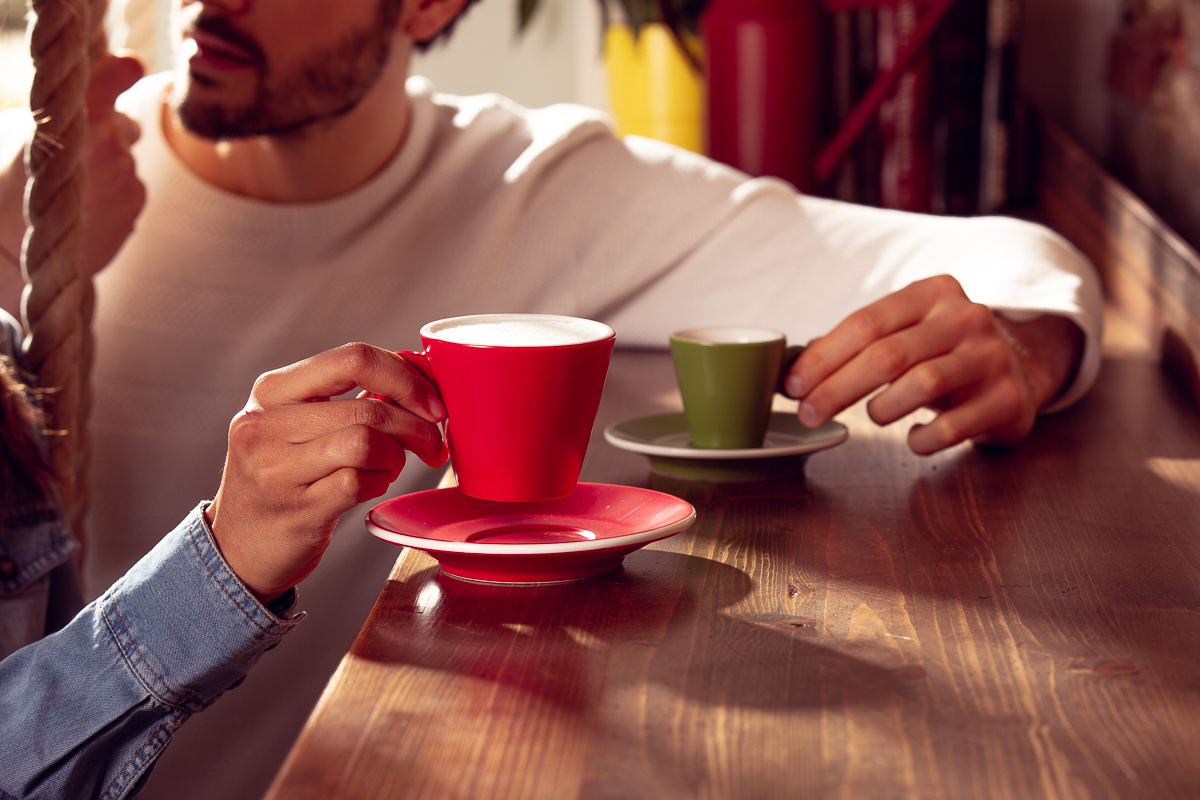























 Espressocups & Espresso coffee cups
Espressocups & Espresso coffee cups